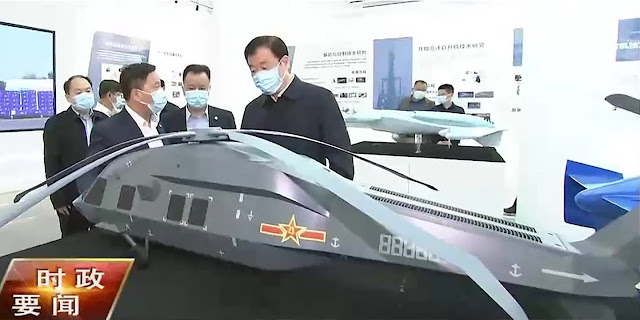PakAlumni Worldwide: The Global Social Network
The Global Social Network
Did Pakistan Help China Access American Stealth Helicopter Technology?
American Defense publication "The Drive" claims that Pakistan has helped China get access to American stealth aircraft technology. Specifically, the American website alleges that the Pakistanis gave Chinese access to the wreckage of the US stealth helicopter destroyed during the American raid to kill Usama Bin Laden in Abbottabad in 2011. Chinese experts have called the accusation "groundless", according to Global Times.
 |
| Chinese Stealth Helicopter Model. Source: Henri Kenhmann |
The accusations surfaced when a Chinese helicopter model, believed to be a variant of the Chinese Z-20 helicopter, was displayed in China on May 19, 2021. The model in question was spotted by @HenriKenhmann who posted a picture of it on social media. Here's how "The Drive" website describes it:
"The aircraft shown appears to be a stealthy adaptation of China's Z-20 medium-lift helicopter, which itself is something of a clone of the H-60 Black Hawk. The Z-20's story is a unique one in itself, as most don't realize that China was a purchaser of the Black Hawk in the '80s, during a period of time when the United States was exporting some military capabilities to China".
Pakistan-China Defense Industry Collaboration Irks West
Pakistan's Aircraft Exports
Pakistan Navy Modernization
Pakistan Launches Defense AI Program
Pakistan Defense Industry
Silicon Valley Book Launch of "Eating Grass"
Pakistan's Human Capital
Pakistan Economy Nears Trillion Dollars
Pakistan's Sea-Based Second Strike Capability
-
Comment by Riaz Haq on June 9, 2021 at 12:10pm
-
#US Senate overwhelmingly passes $250 billion #tech #investment bill aimed at countering #China. The money will be invested in #American #manufacturing and #technology to meet #economic & #strategic challenge from China. #semiconductors #AI #geopolitics https://ti.me/3g5kDZP
Also added to the new bill was a separate initiative that provides $52 billion in incentives and grant programs to bolster domestic semiconductor manufacturing, sought by Republican Senators John Cornyn of Texas and Tom Cotton of Arkansas and Democrats Mark Kelly of Arizona and Mark Warner of Virginia.
The move was cheered by those in the industry, following months of complaints from manufacturers that a semiconductor shortage was hampering the delivery of everything from consumer electronic devices to pickup trucks.
“Semiconductors form the nerve center of America’s economy, national security, and critical infrastructure,” said John Neuffer, the president and CEO of the Semiconductor Industry Association. “We look forward to working with leaders in the administration and Congress to swiftly enact needed federal investments in chip technology to help ensure more of the chips our country needs are researched, designed and manufactured on U.S. shores.”
Darpa Money
That money, along with another $2 billion for related programs, would be available upon the law’s passage. The other spending in the bill would be subject to the appropriations process. An amendment from Senator Ben Sasse, a Republican from Nebraska, would also authorize an additional $17.5 billion for the Defense Advanced Research Projects Agency — or Darpa — over a period of five years.
Some Republicans rejected the idea of the government directing research and industrial policy.
“Maintaining our technological superiority over China requires punishing bad Chinese behavior and relying on the natural innovative entrepreneurship of America’s market economy, not by imitating Chinese central planning,” Pennsylvania GOP Senator Pat Toomey said in a statement before voting against the bill.
Senate GOP leader Mitch McConnell, who had criticized earlier versions of the bill as “not ready for prime time” and weak on defense, said the legislation was an important step forward and a rare area of bipartisan compromise, but should not be the “final word” on U.S. competition with China.
“Needless to say, final passage of this legislation cannot be the Senate’s final word on our competition with China,” McConnell said on the Senate floor. “It certainly won’t be mine.”
Comment
Twitter Feed
Live Traffic Feed
Sponsored Links
South Asia Investor Review
Investor Information Blog
Haq's Musings
Riaz Haq's Current Affairs Blog
Please Bookmark This Page!
Blog Posts
Indian Military Begins to Accept Its Losses in "Operation Sindoor" Against Pakistan
The Indian military leadership is finally beginning to slowly accept its losses in its unprovoked attack on Pakistan that it called "Operation Sindoor". It began with the May 31 Bloomberg interview of the Indian Chief of Defense Staff General Anil Chauhan in Singapore where he admitted losing Indian fighter aircraft to Pakistan in an aerial battle on May 7, 2025. General Chauhan further revealed that the Indian Air Force was grounded for two days after this loss. …
ContinuePosted by Riaz Haq on July 5, 2025 at 10:30am — 2 Comments
Trump Administration Seeks Pakistan's Help For Promoting “Durable Peace Between Israel and Iran”
US Secretary of State Marco Rubio called Pakistan Prime Minister Shehbaz Sharif to discuss promoting “a durable peace between Israel and Iran,” the State Department said in a statement, according to Reuters. Both leaders "agreed to continue working together to strengthen Pakistan-US relations, particularly to increase trade", said a statement released by the Pakistan government.…
ContinuePosted by Riaz Haq on June 27, 2025 at 8:30pm — 5 Comments
© 2025 Created by Riaz Haq.
Powered by
![]()
You need to be a member of PakAlumni Worldwide: The Global Social Network to add comments!
Join PakAlumni Worldwide: The Global Social Network